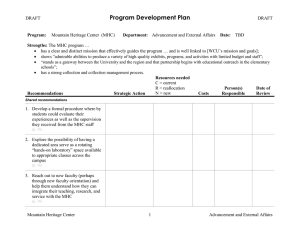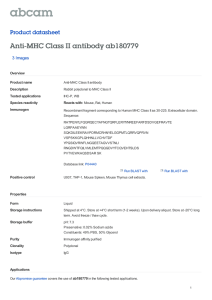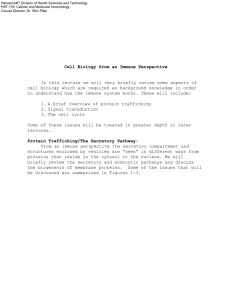Anti-HLA DRB5 antibody ab103256 Product datasheet 1 Image Overview
advertisement
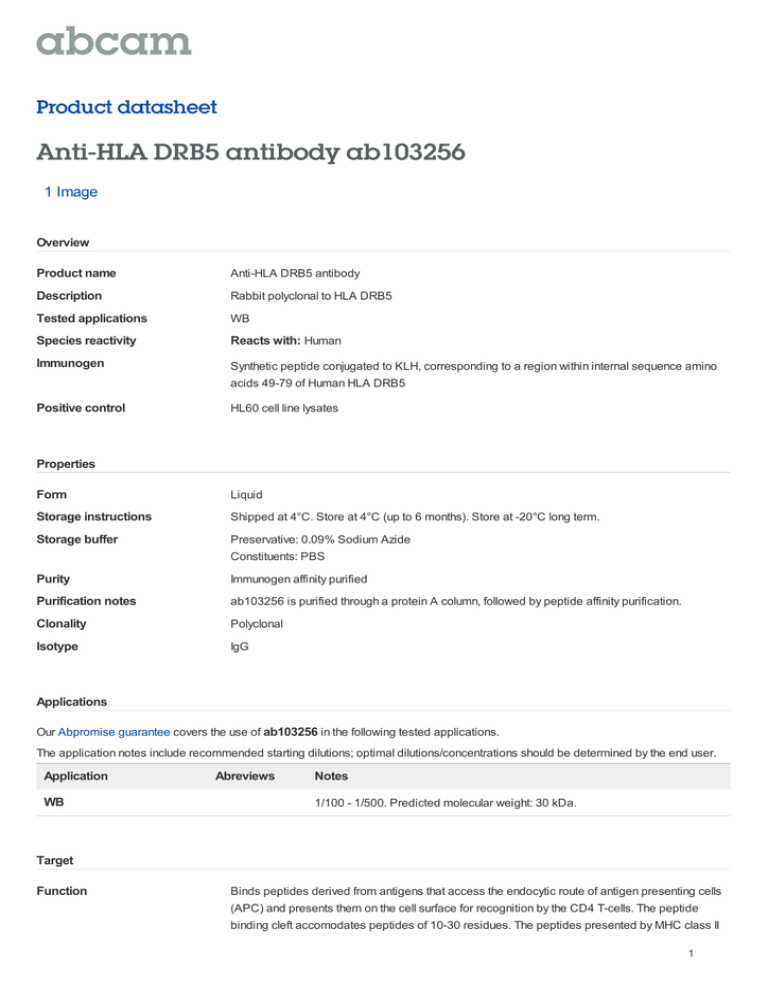
Product datasheet Anti-HLA DRB5 antibody ab103256 1 Image Overview Product name Anti-HLA DRB5 antibody Description Rabbit polyclonal to HLA DRB5 Tested applications WB Species reactivity Reacts with: Human Immunogen Synthetic peptide conjugated to KLH, corresponding to a region within internal sequence amino acids 49-79 of Human HLA DRB5 Positive control HL60 cell line lysates Properties Form Liquid Storage instructions Shipped at 4°C. Store at 4°C (up to 6 months). Store at -20°C long term. Storage buffer Preservative: 0.09% Sodium Azide Constituents: PBS Purity Immunogen affinity purified Purification notes ab103256 is purified through a protein A column, followed by peptide affinity purification. Clonality Polyclonal Isotype IgG Applications Our Abpromise guarantee covers the use of ab103256 in the following tested applications. The application notes include recommended starting dilutions; optimal dilutions/concentrations should be determined by the end user. Application WB Abreviews Notes 1/100 - 1/500. Predicted molecular weight: 30 kDa. Target Function Binds peptides derived from antigens that access the endocytic route of antigen presenting cells (APC) and presents them on the cell surface for recognition by the CD4 T-cells. The peptide binding cleft accomodates peptides of 10-30 residues. The peptides presented by MHC class II 1 molecules are generated mostly by degradation of proteins that access the endocytic route, where they are processed by lysosomal proteases and other hydrolases. Exogenous antigens that have been endocytosed by the APC are thus readily available for presentation via MHC II molecules, and for this reason this antigen presentation pathway is usually referred to as exogenous. As membrane proteins on their way to degradation in lysosomes as part of their normal turn-over are also contained in the endosomal/lysosomal compartments, exogenous antigens must compete with those derived from endogenous components. Autophagy is also a source of endogenous peptides, autophagosomes constitutively fuse with MHC class II loading compartments. In addition to APCs, other cells of the gastrointestinal tract, such as epithelial cells, express MHC class II molecules and CD74 and act as APCs, which is an unusual trait of the GI tract. To produce a MHC class II molecule that presents an antigen, three MHC class II molecules (heterodimers of an alpha and a beta chain) associate with a CD74 trimer in the ER to form an heterononamer. Soon after the entry of this complex into the endosomal/lysosomal system where antigen processing occurs, CD74 undergoes a sequential degradation by various proteases, including CTSS and CTSL, leaving a small fragment termed CLIP (class-IIassociated invariant chain peptide). The removal of CLIP is facilitated by HLA-DM via direct binding to the alpha-beta-CLIP complex so that CLIP is released. HLA-DM stabilizes MHC class II molecules until primary high affinity antigenic peptides are bound. The MHC II molecule bound to a peptide is then transported to the cell membrane surface. In B cells, the interaction between HLA-DM and MHC class II molecules is regulated by HLA-DO. Primary dendritic cells (DCs) also to express HLA-DO. Lysosomal miroenvironment has been implicated in the regulation of antigen loading into MHC II molecules, increased acidification produces increased proteolysis and efficient peptide loading. Sequence similarities Belongs to the MHC class II family. Contains 1 Ig-like C1-type (immunoglobulin-like) domain. Post-translational modifications Ubiquitinated by MARCH1 and MARCH8 at Lys-254 leading to down-regulation of MHC class II. Cellular localization Cell membrane. Endoplasmic reticulum membrane. Golgi apparatus > trans-Golgi network membrane. Endosome membrane. Lysosome membrane. Late endosome membrane. The MHC class II complex transits through a number of intracellular compartments in the endocytic pathway until it reaches the cell membrane for antigen presentation. Anti-HLA DRB5 antibody images Anti-HLA DRB5 antibody (ab103256) at 1/100 dilution + HL60 cell lysate at 35 µg Predicted band size : 30 kDa Western blot - HLA DRB5 antibody (ab103256) Please note: All products are "FOR RESEARCH USE ONLY AND ARE NOT INTENDED FOR DIAGNOSTIC OR THERAPEUTIC USE" Our Abpromise to you: Quality guaranteed and expert technical support Replacement or refund for products not performing as stated on the datasheet 2 Valid for 12 months from date of delivery Response to your inquiry within 24 hours We provide support in Chinese, English, French, German, Japanese and Spanish Extensive multi-media technical resources to help you We investigate all quality concerns to ensure our products perform to the highest standards If the product does not perform as described on this datasheet, we will offer a refund or replacement. For full details of the Abpromise, please visit http://www.abcam.com/abpromise or contact our technical team. Terms and conditions Guarantee only valid for products bought direct from Abcam or one of our authorized distributors 3

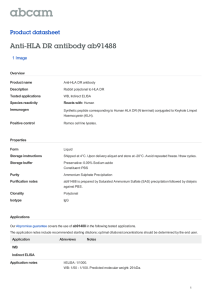
![Anti-HLA-DQA1 antibody [HI118] (PerCP) ab91329 Product datasheet Overview Product name](http://s2.studylib.net/store/data/012448198_1-1438860d79d2655f551f9001711a64ba-300x300.png)

![Anti-HLA-DRB4 antibody [EPR7182] ab140612 Product datasheet 3 Images Overview](http://s2.studylib.net/store/data/012449596_1-c3378e549785d1fd0c675fb2bed92bd1-300x300.png)
![Anti-MHC Class II antibody [CVS20] ab23206 Product datasheet 1 Image Overview](http://s2.studylib.net/store/data/012449522_1-097b21155cbd93e2ac6eb4b7089446f1-300x300.png)


